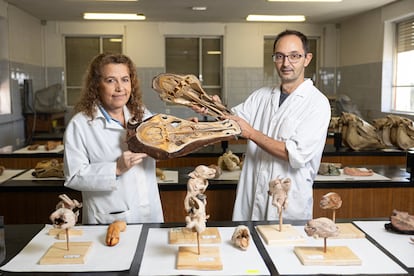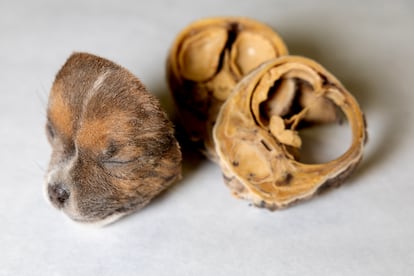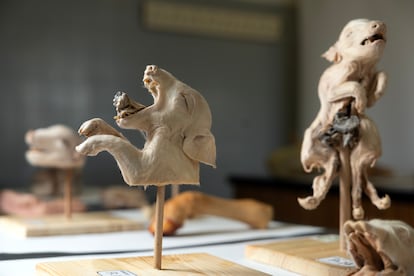Spain's largest collection of birth defects fears closure

Just 500 meters from the Prime Minister's office in the Moncloa Palace lies an astonishing scientific treasure, where at first glance a two-headed piglet and a cyclops calf with a single eye in the middle of its forehead stand out. "This is the largest collection of congenital animal malformations in Spain," proclaims veterinarian Luis Avedillo , clad in a white coat stained with blood. This university professor, who looks like a bookworm, is actually a kind of Indiana Jones of teratology, the discipline that studies " monstrosities ," according to the archaic and pejorative dictionary definition.
Malformations can be unpleasant, even repulsive, so the bodies of these unusual individuals usually end up in a waste container on farms. Avedillo travels throughout the Spanish countryside to find them. He has even dived into hundreds of dead piglets in search of extremely rare birth defects that might shed light on the enigmatic development of a single cell—a fertilized egg—into a creature with trillions of perfectly synchronized cells . Now, with Madrid's public universities facing severe financial hardship due to cuts by Isabel Díaz Ayuso's government, those responsible for this unique collection fear its closure.
Avedillo picks up a piglet displayed on a pedestal, its entrails exposed, and invites those present to hold it. To the touch, it feels like a silicone toy. A quarter of a century ago, Professor Nieves Martín Alguacil created a plastination unit at the Faculty of Veterinary Medicine of the Complutense University of Madrid, to do with animal remains what the German anatomist Gunther von Hagens did with human cadavers—the same anatomist responsible for the controversial exhibitions of plastinated human bodies that have made headlines worldwide. Martín, a full professor, and Avedillo, a lecturer, joined forces to create an exceptional collection of plastinated animals with malformations.
“We’ve been collecting animals for 25 years,” the researcher explains. The stories of his adventures in finding these specimens are endless. One of his main sources is the livestock farmers' association in Recas, a town in Toledo known as Little Mali , because among its 3,200 inhabitants are hundreds of Malians. Avedillo has instructed each of the key workers on these farms, often African, to be vigilant for any abnormalities. Each malformed animal is rewarded with a modest tip. Avedillo does the math. A single farm with 500 sows can have 90 litters every week, with more than a dozen piglets each. “We see in one week what a gynecologist sees in a lifetime,” he concludes.

Last year, the two veterinarians presented a project to create “a reference center for the study of congenital malformations,” which would consist of an exhibition space with their plastinated animals and a collaborative digital platform: a kind of specialized Wikipedia called Malformopedia. Their application was rejected five months ago by the Spanish Foundation for Science and Technology (FECYT), an entity under the Ministry of Science that will fund 193 of the 644 projects submitted to its call for proposals to promote scientific culture. Martín and Avedillo were requesting €23,000 to launch the initiative.
“There isn’t a single center of excellence for congenital malformations anywhere in the world. It would be fantastic to have one here,” the professor laments. Her project highlighted “ the striking similarity ” between human and swine malformations. Martín shows two photographs whose resemblance is chilling: a newborn human baby and a newborn piglet, both with the same defect in the closure of the body wall that causes their organs to protrude like a bunch of grapes. “The value of this collection isn’t to exhibit monstrosities so that people come and are horrified. It has to be a scientific resource for medical researchers, veterinarians, and anyone who wants to learn about congenital malformations,” the professor emphasizes. The World Health Organization estimates that 240,000 newborns die each year from these anomalies.

Biologist Eva Bermejo directs the Spanish Collaborative Study of Congenital Malformations , a research program investigating their causes in humans. Since its inception in 1976, hundreds of scientists have contributed to a database that now exceeds 47,000 cases in newborns. Bermejo, director of the Institute for Research on Rare Diseases at the Carlos III Health Institute, emphasizes that her institution does not house the human specimens and that she is unaware of any collection in Spain similar to that of the Complutense University. “It is a magnificent initiative,” she says. “Congenital defects affect between 2% and 6% of the population and determine a higher risk of premature death, lifelong disability, and dependency. Their care and treatment involve high costs, both for families and for the National Health System itself, so we must take advantage of every opportunity for their prevention,” she warns.
The plastination technique involves extracting bodily fluids from a cadaver using acetone at -20 degrees Celsius, and replacing them with silicone. The process can take a couple of months. Nieves Martín, born in Madrid 61 years ago, learned the technique at the University of Tennessee (USA) and the University of Murcia, where Rafael Latorre 's team has been plastinating animal remains for over three decades to teach anatomy. The company Discover-In emerged from the Murcia laboratory and produces around 400 pieces each year for sale, all free of malformations. Its catalog includes cat brains, goat fetuses, bull penises, and pig hearts. A plastinated cat can cost around 2,000 euros , according to the prices of the Chinese company Meiwo.
The Plastination Unit at the Complutense University of Madrid is a tiny room of barely 15 square meters, containing a chest freezer, a vacuum pump, and metal cabinets filled with malformations preserved in formaldehyde. Adding to their difficulties in finding funding, Martín and Avedillo now face another problem: the Complutense's Occupational Risk Prevention Unit is demanding extremely expensive modifications to the equipment to minimize the risk of explosions, but they cannot afford them. They fear that their dream center of excellence for the study of congenital malformations will become a closed and inaccessible collection. They are asking for help.

Avedillo, born in Valladolid 46 years ago, emphasizes the difficulty of assembling a collection like his, with some 500 cases. Before becoming a university professor, he worked as a veterinarian on dozens of farms and in his own clinic. For a quarter of a century, he has cultivated a network of friends and collaborators among livestock farmers, pet breeders, and farm workers themselves, such as the Malian residents of Toledo who have enthusiastically learned to detect malformations. Finding them is not easy. Often, the sows themselves, weighing up to 300 kilos, crush their piglets until they burst. It's difficult to perceive anything unusual in a scene filled with blood and viscera.
Luis Avedillo and Nieves Martín are disciples of Joaquín Camón , the charismatic innovator of veterinary teratology in Spain, a professor who died in 2009 and who dissected malformed animals while listening to Mozart and Beethoven. In recent years, Avedillo and Martín have shed light on developmental anomalies incats , dogs , and especially pigs . Their plan was to allow any livestock farmer in the world to photograph a malformation, upload the image to Malformopedia for a technical evaluation, and, if the defect was exceptional, plastinate the animal for permanent preservation at the reference center. “Being the first center of its kind in the world would give our country […] international scientific leadership and a model for how to conduct citizen science,” they argued in the proposal that was rejected.
EL PAÍS





